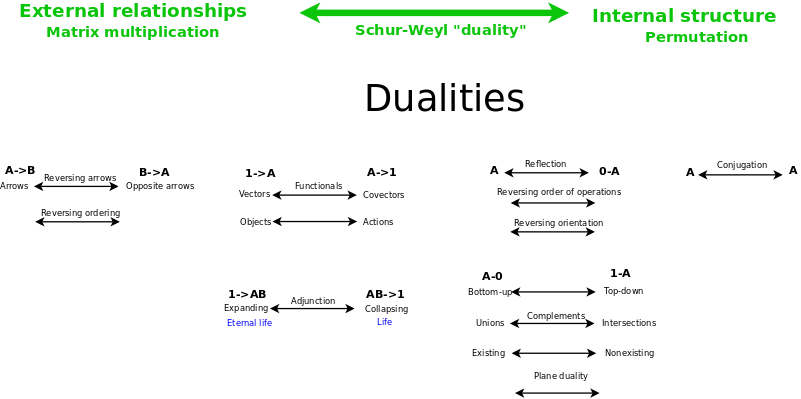Study Groups
Featured Investigations
- How do triangle centers manifest a language?
- Does Bott periodicity model divisions of everything?
- How do economists figure things out?
- How to express Active Inference in Wondrous Wisdom?
Featured Projects
Contact
- Andrius Kulikauskas
- m a t h 4 w i s d o m @
- g m a i l . c o m
- +370 607 27 665
- Eičiūnų km, Alytaus raj, Lithuania
Thank you, Participants!
Thank you, Veterans!
- Jon and Yoshimi Brett
- Dave Gray
- Francis Atta Howard
- Jinan KB
- Christer Nylander
Thank you, Commoners!
- Free software
- Open access content
- Expert social networks
- Patreon supporters
- Jere Northrop
- Daniel Friedman
- John Harland
- Bill Pahl
- Anonymous supporters!
- Support through Patreon!
I am trying to understand  Schur-Weyl duality.
Schur-Weyl duality.
Why master this?
Schur-Weyl duality is an overarching duality that unifies six other dualities.

Schur Weyl duality relates the general linear group and the permutation group, thus relates:
- the duality of external relationships, where {$A\rightarrow B$} is dual to {$B\rightarrow A$}, as in matrix multiplication, where {$a_{ij}$} is dual to {$a_{ji}$}
- the duality of internal structure, where conjugates {$i$} and {$j$} are indistinguishable and of equal significance, as with permutations.
How to learn this?
Some related concepts to learn are:
 Category of representations. In this category, the morphisms are the
Category of representations. In this category, the morphisms are the  equivariant maps.
equivariant maps.
 Frobenius reciprocity This is an adjunction between the functor {$\textrm{Res}^G_H$} restricting a linear representation of a group {$G$} to a linear representation of its subgroup {$H$} and the functor {$\textrm{Ind}^G_H$} inducing a linear representation of {$G$} from a linear representation of {$H$}. This adjunction {$\textrm{Ind}^G_H \dashv\textrm{Res}^G_H$} is of additional interest because if {$G$} and {$H$} are finite groups, then also {$\textrm{Res}^G_H \dashv\textrm{Ind}^G_H$}. I want to understand this adjunction from both sides.
Frobenius reciprocity This is an adjunction between the functor {$\textrm{Res}^G_H$} restricting a linear representation of a group {$G$} to a linear representation of its subgroup {$H$} and the functor {$\textrm{Ind}^G_H$} inducing a linear representation of {$G$} from a linear representation of {$H$}. This adjunction {$\textrm{Ind}^G_H \dashv\textrm{Res}^G_H$} is of additional interest because if {$G$} and {$H$} are finite groups, then also {$\textrm{Res}^G_H \dashv\textrm{Ind}^G_H$}. I want to understand this adjunction from both sides.
 Maschke's theorem states that every representation of a finite group G over a field F with characteristic not dividing the order of G is a direct sum of irreducible representations. It seems this theorem makes use of the concepts of restriction and induction. I am also interested in the module theoretic version of this theorem because it is related to
Maschke's theorem states that every representation of a finite group G over a field F with characteristic not dividing the order of G is a direct sum of irreducible representations. It seems this theorem makes use of the concepts of restriction and induction. I am also interested in the module theoretic version of this theorem because it is related to  Wedderburn-Artin theorem which describes how semisimple rings are products of finite-dimensional matrix rings over division rings. The latter theorem is used in the
Wedderburn-Artin theorem which describes how semisimple rings are products of finite-dimensional matrix rings over division rings. The latter theorem is used in the  classification of Clifford algebras and thus is relevant for Bott periodicity.
classification of Clifford algebras and thus is relevant for Bott periodicity.
I am watching a helpful series of videos by Monica Vazirani: Representation Theory and Combinatorics of the Symmetry Group and Related Structures, Part II, Part III.


